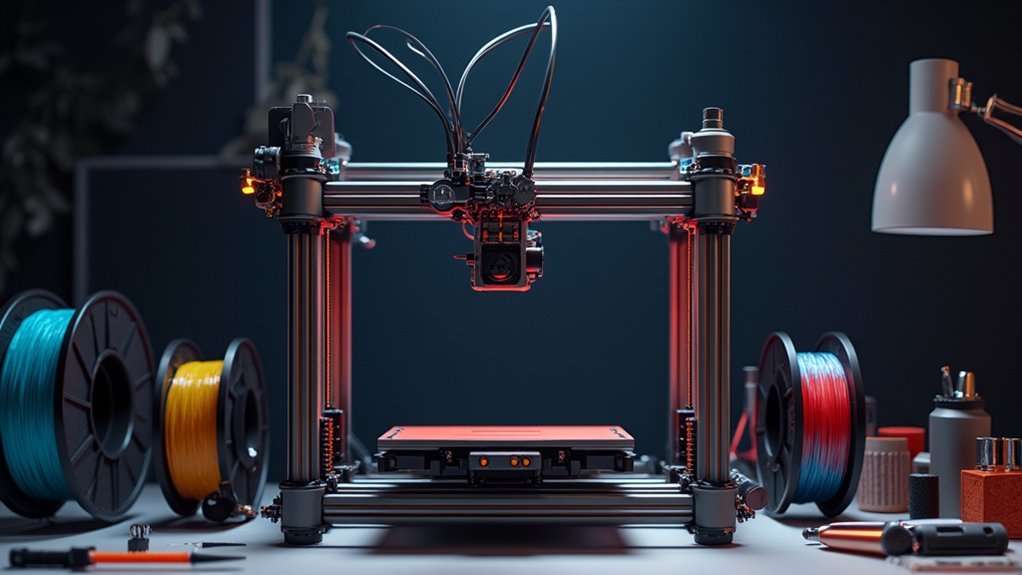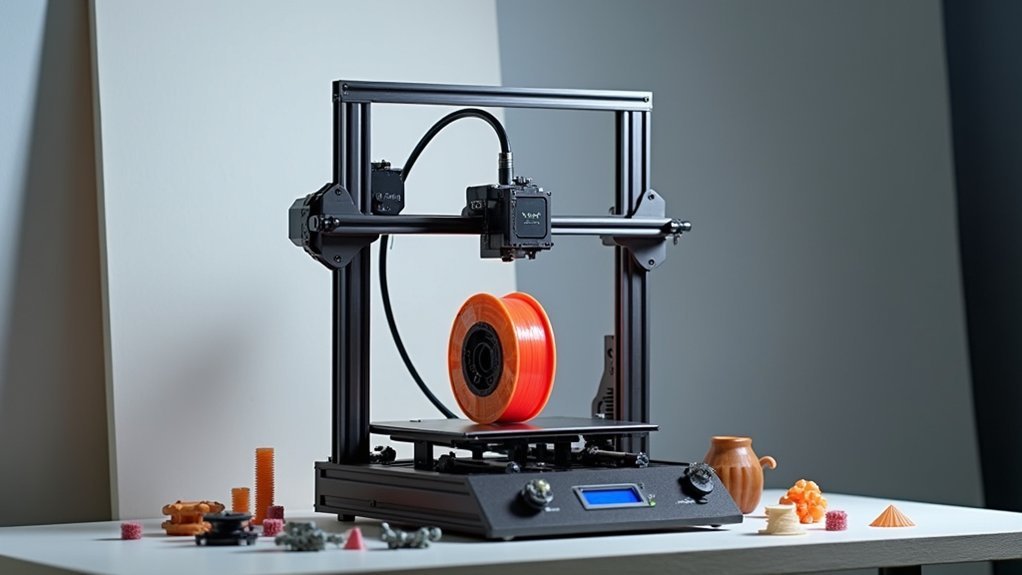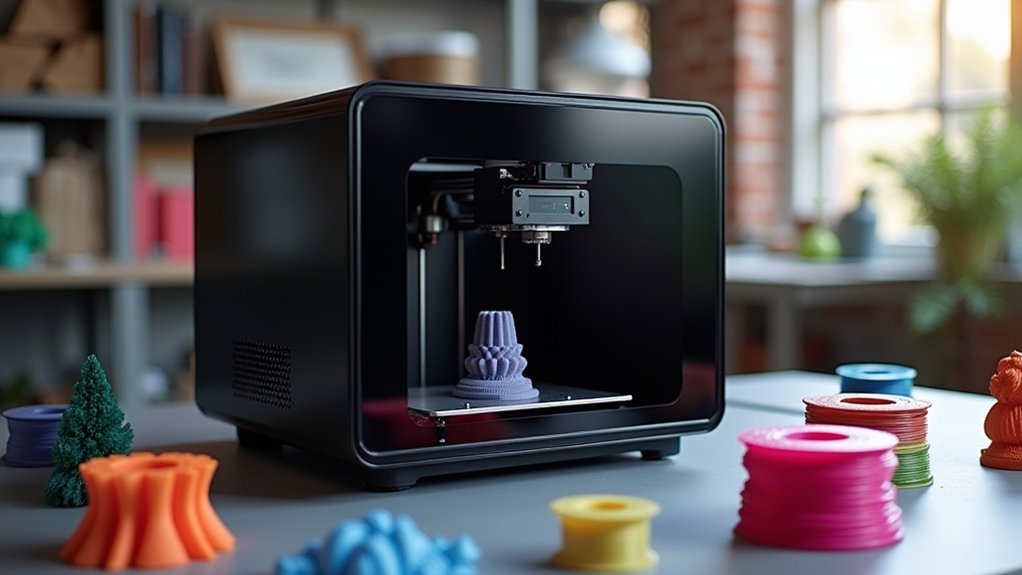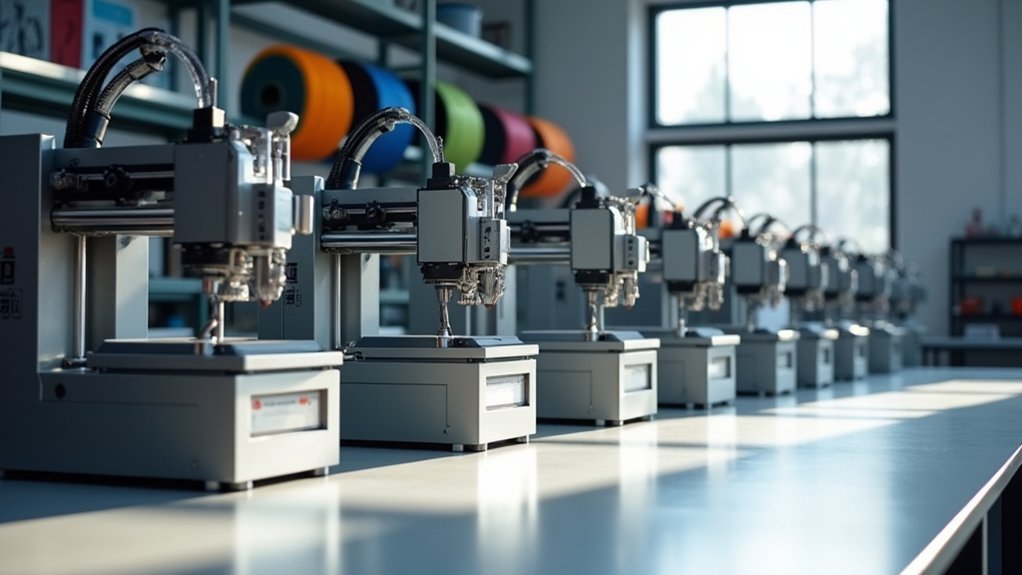You’ll find exceptional multi-material printing capabilities in today’s automatic tool changer 3D printers, from the Original Prusa XL’s five-toolhead system to the Bambu Lab X1 Carbon’s AI-driven precision. The E3D Motion System offers robust open-source flexibility, while Makertech’s QUAD-CORE-XY delivers incredible 60K mm/s² acceleration. Independent dual extruder systems like the Raise3D E2CF and BCN3D Epsilon W50 eliminate cross-contamination entirely. The Ultimaker S5 Pro Bundle rounds out your options with six-spool automation and 20-micron precision for professional results across diverse materials and applications.
Original Prusa XL 5-Toolhead System

When you need exceptional multi-material printing capabilities, the Original Prusa XL’s five-toolhead system delivers unmatched efficiency by eliminating the excessive filament waste that plagues traditional color-changing methods.
This advanced tool changer enables seamless switching between materials like Flex, PETG, and PLA within your 360×360×360 mm build volume.
You’ll achieve layer heights from 0.10 mm to 0.30 mm while maintaining high speeds through Input Shaper and Pressure Advance technologies.
The Spool Join feature automatically manages up to five 2kg spools, dramatically reducing downtime during extended prints.
Advanced spool management eliminates print interruptions, keeping your multi-material projects running smoothly with minimal operator intervention required.
With its loadcell sensor providing automatic calibration, you’re guaranteed perfect first layers across different print surfaces, ensuring consistent reliability throughout your multi-material projects.
E3D Motion System and ToolChanger
For professionals seeking uncompromising versatility, the E3D Motion System and ToolChanger delivers four swappable tool heads within a robust open-source platform that transforms your printing capabilities.
You’ll appreciate its 300 x 200 x 300 mm build volume and exceptional 500°C maximum nozzle temperature, enabling compatibility with virtually any material. The open-source design provides free spare parts through GitHub, fostering community engagement.
Key advantages include:
- Professional Performance – Achieves 75° overhang success rates with dimensional accuracy matching industrial FFF systems
- Advanced Configuration – Duet Wi-Fi web interface enables custom G-code profiles for optimized printing
- DIY-Friendly Assembly – 15-hour build time with thorough documentation for enthusiasts
While lacking some safety features, this system excels for users demanding maximum flexibility and precision in their multi-material printing workflows.
Makertech 3D Proforge 4 QUAD-CORE-XY

You’ll find the Makertech 3D Proforge 4 stands out with its innovative QUAD-CORE-XY technology that delivers exceptional acceleration up to 60K mm/s².
This system powers four independent print heads, enabling you to work with multiple materials simultaneously while maintaining impressive speed and precision.
The combination of high-performance motion control and multi-head capabilities makes this printer a compelling choice for complex, multi-material projects.
Quad-Core-XY Technology
Although traditional 3D printers often struggle with speed-versus-quality trade-offs, the Makertech 3D Proforge 4’s QUAD-CORE-XY technology revolutionizes multi-material printing by achieving maximum accelerations of 60K mm/s² without sacrificing precision.
This advanced architecture delivers exceptional performance through its innovative design.
You’ll benefit from three key advantages:
- Minimized inertia and maximized stability – The system reduces vibrations during high-speed operations while maintaining structural integrity.
- Rapid, precise tool changes – Four print heads execute seamless shifts between materials without quality degradation.
- Exceptional dimensional accuracy – Advanced motion control preserves surface finish quality even at maximum speeds.
This technology transforms your multi-material prints by optimizing the printer’s architecture for high-performance applications, making it ideal whether you’re a professional or hobbyist seeking versatile printing solutions.
High-Speed Performance Capabilities
The Makertech 3D Proforge 4’s QUAD-CORE-XY architecture doesn’t just enable precision—it releases remarkable speed capabilities that redefine what’s possible in multi-material printing. You’ll experience unprecedented acceleration of 60K mm/s², transforming your workflow efficiency. The QUAD-CORE-XY technology maximizes throughput while maintaining quality across the substantial 400x300x400mm print volume.
| Performance Metric | Specification | Benefit |
|---|---|---|
| Maximum Acceleration | 60K mm/s² | Ultra-fast layer shifts |
| Print Heads | 4 simultaneous | Multi-material capability |
| Build Volume | 400x300x400mm | Large project accommodation |
| Tool Change Speed | Rapid shift | Minimal downtime |
Your high-speed performance capabilities aren’t compromised by the printer’s multi-material functionality. Instead, you’ll find that combining materials and colors happens seamlessly, maintaining the accelerated pace that professional applications demand.
Four-Head Tool System
When precision meets versatility, the Makertech 3D Proforge 4’s four-head tool system emerges as a game-changer for complex printing applications.
You’ll experience unprecedented material flexibility with this innovative configuration that alters how you approach multi-material projects.
The four-head tool system delivers three key advantages:
- Material Diversity – Switch between different filament types mid-print without manual intervention
- Color Complexity – Create intricate multi-colored designs with seamless changes
- Support Optimization – Use dedicated heads for support materials while maintaining primary print quality
You’ll maximize your 400x300x400 mm build volume potential through simultaneous material processing.
The open-source design lets you customize each head’s configuration to match specific project requirements.
With £232,618 in community funding backing this technology, you’re investing in proven innovation that enhances both professional workflows and creative experimentation.
Bambu Lab X1 Carbon Multi-Material System

Innovation meets precision in the Bambu Lab X1 Carbon Multi-Material System, which stands out as a desktop powerhouse for creators seeking professional-grade automatic tool changing capabilities.
You’ll experience seamless shifts between different filament types during printing, thanks to its high-speed automatic tool changer that eliminates manual intervention.
The 256 x 256 x 256 mm build volume provides ample space for diverse projects while maintaining compact desktop dimensions.
You’ll appreciate the AI-driven features that handle automatic calibration and filament detection, ensuring consistent results every time.
With maximum speeds reaching 500 mm/s and layer resolution down to 0.1 mm, you’re getting exceptional speed without sacrificing quality.
The modular design lets you upgrade components easily, making this system adaptable for future needs.
Raise3D E2CF Independent Dual Extruder
You’ll find the Raise3D E2CF takes a different approach with its independent dual extruder system that lets you print two materials simultaneously without tool changing mechanisms.
This design gives you professional-grade multi-material capabilities, supporting everything from standard filaments to engineering materials like carbon fiber and nylon.
The printer’s robust enclosed construction and large 330 x 240 x 240 mm build volume make it a solid choice for professional applications requiring reliable dual-material printing.
Independent Extruder Design
Although many dual-extruder 3D printers suffer from cross-contamination and clogging issues, the Raise3D E2CF’s independent dual extruder design eliminates these problems by completely separating the two material paths.
This innovative independent extruder design guarantees each filament maintains its integrity throughout the printing process.
The system’s key advantages include:
- Zero cross-contamination – Complete material path separation prevents mixing between filaments
- Seamless material switching – You can change between different materials or colors mid-print without interruption
- Enhanced reliability – Independent operation reduces clogging risks and maintenance requirements
You’ll appreciate the precise filament management this independent extruder design provides.
Whether you’re printing with PLA, ABS, PETG, or specialty carbon fiber filaments, each extruder operates autonomously, delivering consistent results across your entire 330 x 240 x 240 mm build volume.
Multi-Material Print Capabilities
The Raise3D E2CF’s independent dual extruder system transforms complex multi-material printing into a straightforward process.
You’ll simultaneously print with two different materials, creating intricate designs that combine various properties within single parts. The printer’s multi-material capabilities extend beyond basic PLA combinations—you can work with carbon fiber filaments alongside standard materials, producing lightweight yet exceptionally strong components.
With nozzle temperatures reaching 300°C, you’re not limited to conventional filaments. You can combine advanced materials like nylon and polycarbonate with regular plastics, opening possibilities for functional prototypes and end-use parts.
The 330 x 240 x 240 mm build volume accommodates substantial multi-material projects, while automated bed leveling maintains consistent adhesion across different material types, preventing warping and ensuring reliable prints every time.
Professional Build Quality
Beyond versatile material combinations, Raise3D engineered the E2CF with industrial-grade construction that delivers consistent professional results.
You’ll appreciate how the printer’s robust design guarantees reliable operation across demanding production environments. The printing community recognizes this machine’s exceptional professional build quality through its precision-engineered components and manufacturing standards.
Three key construction features that set the E2CF apart:
- Heated build plate with enclosed chamber – Maintains ideal temperature conditions while preventing warping on challenging materials like carbon fiber and nylon
- Advanced automatic calibration system – Eliminates manual adjustments and assures precise first layer placement every time
- 330 x 240 x 240 mm build volume – Provides substantial workspace for large-scale professional prototypes and end-use parts
You’re investing in equipment that consistently delivers production-ready components.
BCN3D Epsilon W50 Independent Dual Extruder
Innovation takes center stage with BCN3D’s Epsilon W50, which delivers professional-grade printing through its Independent Dual Extruder (IDEX) system.
You’ll appreciate how this independent dual extruder technology eliminates cross-contamination between materials, enabling seamless multi-material and multi-color printing simultaneously.
The printer’s generous 420 x 300 x 400 mm build volume lets you tackle large projects or batch multiple smaller parts efficiently.
With substantial 420 x 300 x 400 mm build dimensions, you’ll handle ambitious projects or efficiently batch smaller components with confidence.
You can work with engineering-grade filaments confidently, thanks to the heated chamber that maintains ideal temperatures throughout the printing process.
The automatic bed leveling system guarantees you’ll get consistent first layers every time, while the color touchscreen interface and Wi-Fi connectivity make remote monitoring effortless.
You’re getting professional reliability with user-friendly operation that streamlines your workflow.
Ultimaker S5 Pro Bundle Multi-Material Setup
Six material spools working in perfect harmony define Ultimaker’s S5 Pro Bundle approach to professional multi-material printing.
The Material Station automatically feeds filament to your dual extrusion system, eliminating manual swapping interruptions during complex projects.
Your 330 x 240 x 300 mm print bed accommodates substantial multi-material creations while maintaining 20-micron precision through advanced print core technology.
You’ll appreciate seamless PLA-PVA combinations for complex geometries requiring dissolvable supports.
The system’s professional-grade features include:
- Automatic material handling – Six 750g spools feed continuously without intervention
- Dual extrusion precision – Combine materials simultaneously for enhanced design flexibility
- Remote monitoring capabilities – Track progress through the Ultimaker app’s intuitive interface
This bundle transforms your workflow by reducing downtime and expanding creative possibilities through reliable, automated material management.
Frequently Asked Questions
What Is the Best Auto Leveling 3D Printer?
You’ll find the Original Prusa XL stands out as the best auto-leveling 3D printer, featuring advanced loadcell sensors and automatic calibration that’ll guarantee perfect first layers while greatly reducing your setup time.
What Is the 45 Degree Rule for 3D Printing?
You shouldn’t print overhangs exceeding 45 degrees from vertical without supports. This rule prevents sagging and print failures by ensuring each layer has enough surface area to properly adhere to the layer below.
What 3D Printer Does Jay Leno Use?
You’ll find Jay Leno uses the E3D ToolChanger, a professional FFF 3D printer featuring swappable tool heads. It’s priced around $2,800 and offers a 300x200x300mm build volume for his automotive projects.
How Often Should You Auto Level a 3D Printer?
You should auto level your 3D printer before each print to guarantee proper first layer adhesion. It’s a quick few-minute process that’s essential for maintaining consistent print quality across different materials.





Leave a Reply